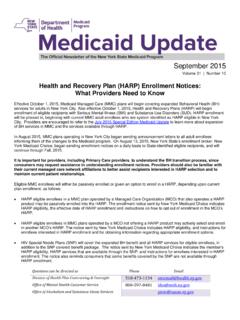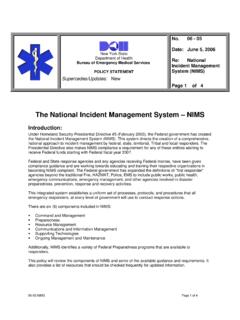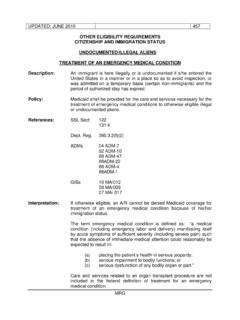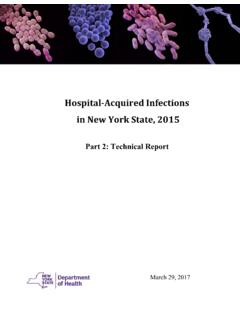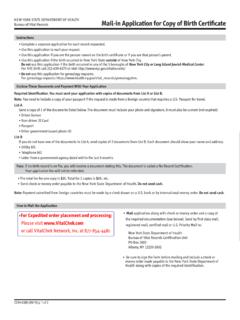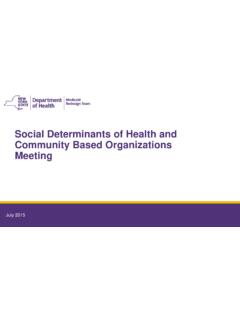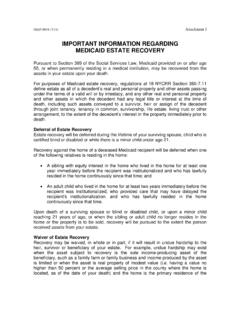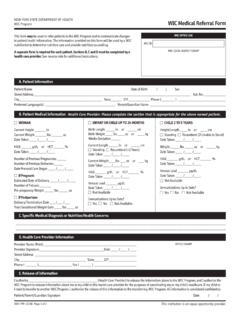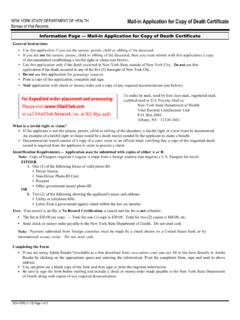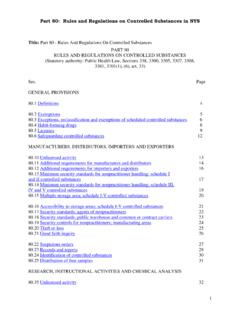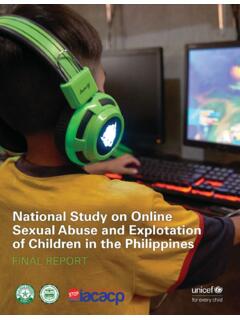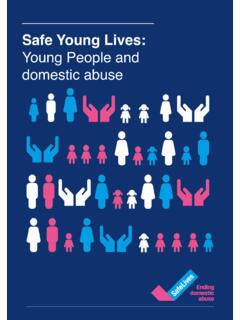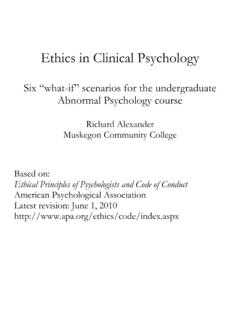Transcription of Nursing Home Incident Reporting Manual
1 Nursing Home Incident Reporting Manual Division of Nursing Homes and ICF/IID Surveillance Center for Health Care Provider Services and Oversight Office of Primary Care and Health Systems Management New York State Department of Health August 2016 Table of Contents Section I: General Information about Incident Reporting Introduction .. 1 Reporting Requirements .. 1 Emergency Section II: Incident Categories and Reporting scenarios with Questions and Answers Incident Categories .. 5 abuse , MISTREATMENT, NEGLECT, MISAPPROPRIATION abuse (Physical) .. 6 abuse ( sexual ) .. 8 abuse (Verbal) .. 10 abuse (Mental).. 12 Mistreatment .. 13 Neglect .. 14 Misappropriation .. 16 QUALITY OF CARE Medication Error/Drug Diversion .. 18 Injury of Unknown Origin .. 19 Burns .. 20 Attempted Suicide or Death or Injury Related to Suicide, Restraints, Equipment or Death Related to Falls.
2 21 Accidents (Choking) .. 22 Residents Found in Non-Resident Area .. 23 CPR Concerns .. 23 24 PHYSICAL ENVIRONMENT Malfunction or Misuse of Equipment .. 25 Physical Plant Issues/Loss of Service .. 25 Smoke and Fire .. 25 Evacuation .. 26 ADDITIONAL Reporting Safe Medical Device Act .. 26 Section III: Reporting Instructions Reporting Instructions .. 27 1 Section I: General Information about Incident Reporting Introduction This Manual is available to all skilled Nursing facility staff responsible for Reporting alleged violations of mistreatment, neglect and abuse , including injuries of unknown source and misappropriation of resident property, to the New York State Department of Health (NYS DOH).
3 The Manual is intended to provide clarification and guidance on what incidents are reportable and how they should be reported. Nothing in this Manual affects the requirement for facilities to report emergencies and disasters to the New York State Watch Center operated by the New York State Office of Emergency Management: Reporting Requirements In December 2004, the Centers for Medicare and Medicaid Services (CMS) issued clarification on facilities' obligations to report allegations and results of the investigation of alleged violations involving mistreatment, neglect or abuse , including injuries of unknown origin and misappropriation of resident property. Federal (42 CFR ) and State (10 NYCRR ) regulations require the facility to report alleged violations of mistreatment, neglect and abuse , including injuries of unknown origin and misappropriation of resident property, immediately to the administrator of the facility and to other officials in accordance with State law ( , the NYS DOH).
4 Per CMS, "immediately" means as soon as possible, but not to exceed 24 hours after discovery of the Incident (State Operations Manual , Appendix PP, Interpretive Guidelines, Section (c)(2) and (4)). The facility must simultaneously initiate an investigation and prevent further potential abuse while the investigation is in progress. The results of all investigations must be reported to the facility administrator and the NYS DOH, if requested, within five working days of the Incident . If the alleged violation is verified, appropriate corrective action must be taken. Information from the investigation must be maintained in the facility. The Elder Justice Act (under Section 1150B of the Social Security Act, as established by Section 6703(b)(3) of the Patient Protection and Affordable Care Act of 2010) requires specific individuals in applicable long-term care facilities ( Nursing homes, etc.)
5 To report any reasonable suspicion of a crime against a resident of the facility to at least one local law enforcement agency of jurisdiction and the NYS DOH. Affected individuals include the owner, operator, employee, manager, agent or contractor of the facility. The New York State Attorney General s Office, Medicaid Fraud Control Unit has jurisdiction to safeguard elderly and disabled New Yorkers from abuse and neglect in Nursing homes and other health care facilities, and qualifies as a local law enforcement agency for this purpose. Time frames for Reporting are as follows: 2 Incidents resulting in serious bodily injury must be reported within two hours after forming the suspicion. All other incidents must be reported within 24 hours. The facility must have policies and procedures that comply with this law. The law prohibits retaliation by a long-term care facility against any individual who makes such a report and establishes distinct penalties, including a fine of up to $200,000, for an individual's failure to report within the above-noted time frames (up to $300,000 if such failure exacerbates the harm to the victim of the crime).
6 In addition, the facility is required to conspicuously post notice to all employees informing them of their Reporting obligations and annually provide personal notice of such obligations to those employees subject to the Reporting obligations. Further information in this regard can be found in CMS S&C: 11-30-NH, Reporting Reasonable Suspicion of a Crime in a Long-Term Care Facility (LTC): Section 1150B of the Social Security Act. If a crime is suspected, it must be reported to local law enforcement under the requirements of the Elder Justice Law. The Patient abuse Reporting Law, Public Health Law (PHL) Section 2803-d was enacted in 1977 to protect persons living in Nursing homes from physical abuse , mistreatment or neglect. The law requires every Nursing home employee -- including administrators and operators -- and all licensed professionals, whether or not employed by the Nursing home, to report to the NYS DOH when there is reasonable cause to believe that a resident has been physically abused, mistreated or neglected.
7 Such reports must be made within 48 hours. The law requires the NYS DOH to investigate all such allegations, and also outlines penalties for individuals who are found guilty of these acts and anyone who is required to report, but fails to do so. 10 NYCRR, Section (d) defines "reasonable cause" to mean that upon a review of the circumstances, there is sufficient evidence for a prudent person to believe that physical abuse , mistreatment or neglect has occurred. Circumstances that may lead to a reasonable cause conclusion may include, but are not limited to: A statement that physical abuse , mistreatment or neglect has occurred. The presence of a physical condition (such as a bruise) that is inconsistent with the resident's history or course of treatment. The visual or auditory observation of an act or condition of physical abuse , mistreatment or neglect.
8 Information from the facility's review of the circumstances must be maintained in the facility. 3 If the reasonable cause threshold has not been met, notification to the NYS DOH is not required. In addition to abuse , mistreatment, neglect and misappropriation, this Manual contains a list of other specific incidents that must also be reported to the NYS DOH. Summary of Reporting Requirements Investigate Incident immediately upon discovery. Identify if abuse , neglect, mistreatment, misappropriation, injury of unknown origin and certain incidents occurred. Submit Incident report via the Health Commerce System (HCS) immediately, once the reasonable cause threshold is met for abuse , neglect, and mistreatment. Report all other incidents via the HCS within 24 hours. Facilities have 5 days to complete their investigation. Reporting incidents to the NYS DOH does not relieve the facility from its responsibility to report to other agencies.
9 The facility must begin an investigation immediately upon discovery of an Incident . The investigation must be complete and thorough, and further potential abuse must be prevented while the investigation is in progress. Documents associated with the facility investigation include, but are not limited to: Complete electronic Incident form on the HCS and have available: Witness statement(s) Resident statement(s) Accused statement(s) Facility investigation report Resident(s) medical record Care plan(s) and diagnoses Resident cognition evaluation Employee personnel and training records Report /case ID number from law enforcement, if reported Plan to prevent reoccurrence 4 Nights, Weekends, Holiday Emergency Notification To report a facility involvement in emergency and/or disaster on nights, weekends, or holidays call: NYSDOH Duty Officer at 1-866-881-2809 During normal business hours Monday through Friday (8 to 5 ), please continue to contact the NYSDOH Regional Office in the customary manner.
10 Capital District Regional Office - 518-408-5372 Central New York Regional Office - 315-477-8472 Metropolitan Regional Office New York City 212-417-4999 Long Island 631-851-3612 New Rochelle 914-654-7058 Western Regional Office Buffalo 716-847-4320 Rochester 585-423-8020 The NYSDOH Duty Officer number will forward the call to a NYSDOH staff person. The bullets listed below outline the process that will follow your call to the Duty Officer: o You will be prompted to leave a message and a number where you can be reached. o The Duty Officer will call back promptly, so remain at that number. o There is one Duty Officer on call for all of New York State. When your call is returned, he/she will ask for the type of emergency, and the type of facility ( hospital, Nursing home, adult home) involved.
